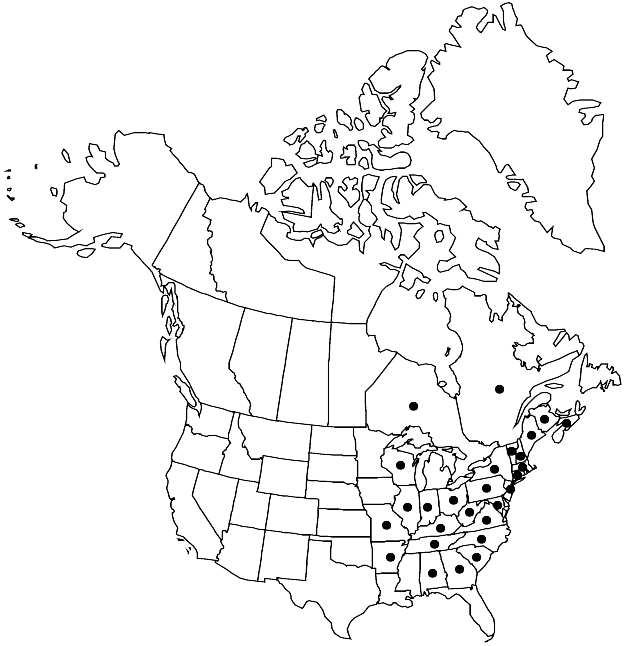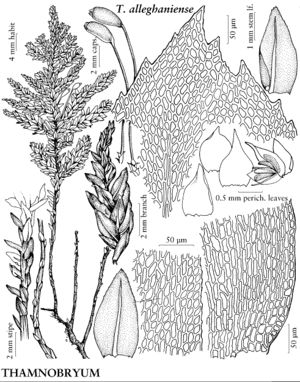Difference between revisions of "Thamnobryum alleghaniense"
Amer. Midl. Naturalist 5: 51. 1917.
FNA>Volume Importer |
FNA>Volume Importer |
||
| Line 29: | Line 29: | ||
|elevation=moderate elevations | |elevation=moderate elevations | ||
|distribution=N.B.;N.S.;Ont.;Que.;Ala.;Ark.;Conn.;Ga.;Ill.;Ind.;Ky.;Maine;Md.;Mass.;Mo.;N.H.;N.J.;N.Y.;N.C.;Ohio;Pa.;S.C.;Tenn.;Vt.;Va.;W.Va.;Wis.;Europe;Asia (China). | |distribution=N.B.;N.S.;Ont.;Que.;Ala.;Ark.;Conn.;Ga.;Ill.;Ind.;Ky.;Maine;Md.;Mass.;Mo.;N.H.;N.J.;N.Y.;N.C.;Ohio;Pa.;S.C.;Tenn.;Vt.;Va.;W.Va.;Wis.;Europe;Asia (China). | ||
| − | |discussion=<p>Thamnobryum alleghaniense is distinguished by the elongate-rhombic apical cells of the branch leaves, and by the longest axis of medial cells near the costa oriented at a 45° angle. The branches are incurved when dry.</p> | + | |discussion=<p><i>Thamnobryum alleghaniense</i> is distinguished by the elongate-rhombic apical cells of the branch leaves, and by the longest axis of medial cells near the costa oriented at a 45° angle. The branches are incurved when dry.</p> |
|tables= | |tables= | ||
|references= | |references= | ||
| Line 52: | Line 52: | ||
|publication year=1917 | |publication year=1917 | ||
|special status=Selected by author to be illustrated | |special status=Selected by author to be illustrated | ||
| − | |source xml=https://jpend@bitbucket.org/aafc-mbb/fna-data-curation.git/src/ | + | |source xml=https://jpend@bitbucket.org/aafc-mbb/fna-data-curation.git/src/8f726806613d60c220dc4493de13607dd3150896/coarse_grained_fna_xml/V28/V28_966.xml |
|genus=Thamnobryum | |genus=Thamnobryum | ||
|species=Thamnobryum alleghaniense | |species=Thamnobryum alleghaniense | ||
Revision as of 17:09, 18 September 2019
Plants (3–)5–8(–10) cm. Secondary stem leaves 2–3.5 × 1.4 mm. Branch leaves ovate, 1.5–2 × 0.5–0.6 mm; margins coarsely serrate at apex; apex acute to acuminate; basal laminal cells 6–10 × 1–2 µm; medial juxtacostal cells short-rhomboidal, longest axis 45° to costa, 3–5 × 1–2 µm; apical cells elongate-rhombic, 3–5 × 1–2 µm. Sexual condition synoicous or autoicous.
Habitat: Rock, logs, deeply shaded wet rock ledges, limestone cliffs, sandstone of Tsuga hardwood forests, mixed deciduous forests
Elevation: moderate elevations
Distribution

N.B., N.S., Ont., Que., Ala., Ark., Conn., Ga., Ill., Ind., Ky., Maine, Md., Mass., Mo., N.H., N.J., N.Y., N.C., Ohio, Pa., S.C., Tenn., Vt., Va., W.Va., Wis., Europe, Asia (China).
Discussion
Thamnobryum alleghaniense is distinguished by the elongate-rhombic apical cells of the branch leaves, and by the longest axis of medial cells near the costa oriented at a 45° angle. The branches are incurved when dry.
Selected References
None.
